We had ten broken drones in a year, test flights twice a day, three PhDs in the team, a prototype of sushi sticks and a desire to find a way to stop hitting drones.
Very controversial, very unusual, very strange, but it works! At the intersection of architecture, collaborative robotics and unmanned aerial vehicles.
Introducing: Tensodrone™.
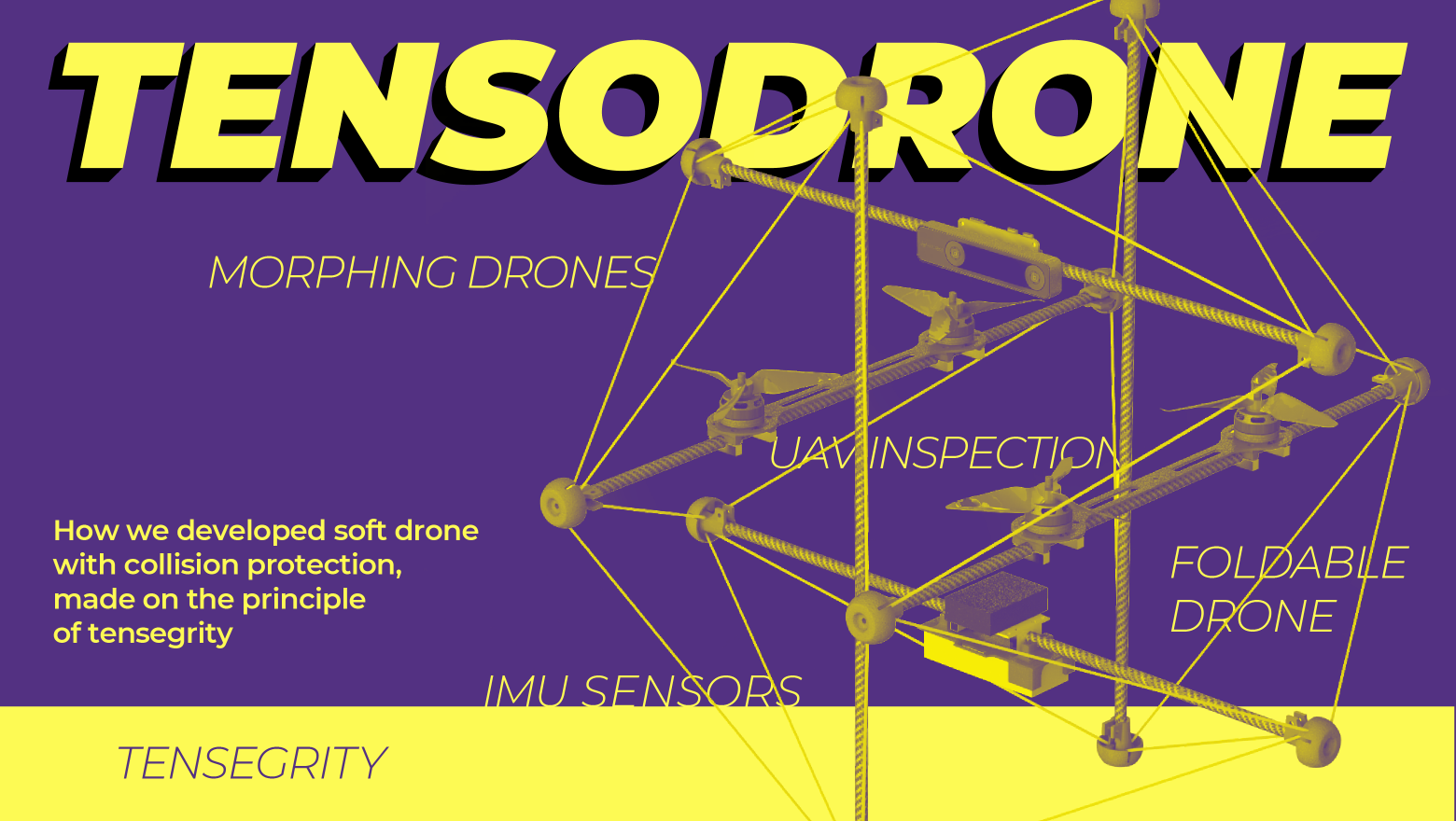
Tensodrone is a multi-rotor UAV of a new design with collision protection, made on the principle of tensegrity. This approach allows for the combination of the protective cage and the airframe in one structure, increasing impact resistance with less weight. The project is a vivid example of the interaction of various teams of the Center for Competences of the National Technology Initiative in the field of «Robotics and Mechatronics» established at the Innopolis University in 2018.

Source
Just because they fly.
Drone developers are trying to make control systems, motors, sensors, autopilots, on-board computers and software as reliable as possible, but the risk remains. If you are a drone developer dealing with a drone prototype, moreover, you should prepare for falls and crashes (make a few extra pieces or a few dozens?). In addition to internal factors, there are obviously external factors — wind, passive obstacles, active influence.
Hardly anyone will argue, drones fall, collide, crash. You can try to avoid this, you can prepare for it. What's better? It's up to the developer, user and authorities.
I prefer to use both methods. But in this article we will focus on how to avoid the consequences of a fall or collision of a UAV, assuming that such a collision is possible.
The most straightforward approach to avoiding the consequences of a UAV crash or collision is a protective cage and other protective structures.
There are 2 tasks here — to protect the drone from damage and to protect the environment where the drone operates and the people in it from the drone.
The basic version of the design, rather related to protect people from the drone, is the propeller guard.
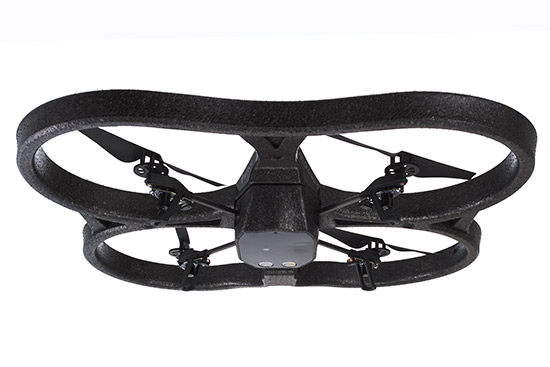
AR.Drone 2.0 drone with propeller guards. Source
There are also interesting solutions, inspired by origami, for foldable flexible propeller guards (and even frame designs), which are being developed at EPFL by Prof. Floreano’s group.
The prevailing design for protecting the drone itself (and at the same time people from it) is a protective cage. The quadcopter itself is inside the cage.

The Clover drone from COEX
Russian company COEX makes drones for educational purposes, which by default have propeller guards and, optionally, a protective cage.

Flyability ELIOS drone
Flyability, a Swiss company, produces perhaps the most commercially successful drone ELIOS with a protective cage for indoor inspections. The originality of the design consists of attaching the protective cage to the frame of the copter on a movable suspension (gimbal) with the possibility of stabilization. I also recently learned about a certain similar Russian startup: Safecopter.
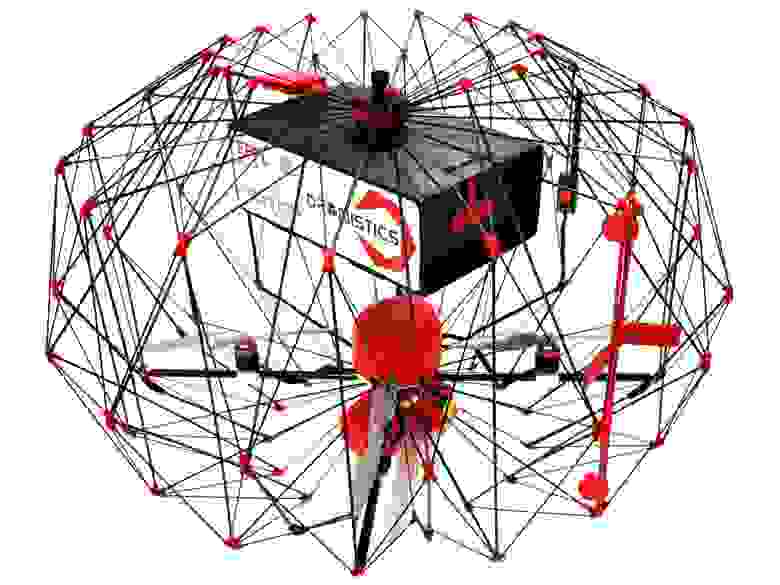
Dronistics Drone
Startup Dronistics from EPFL (emerged from Floreano’s group) offers a drone with a foldable cage for safe delivery.
The disadvantage of drone cages is the increase in the mass of the structure by the amount of the mass of the protective cage and the elements of its attachment to the UAV. The desire to reduce the weight of the structure leads to a decrease in the strength of the protection.
Another direction related to the ideas of a protected drone (and not only to it) is folding drones and drones with variable geometry (morphing) drones. This refers to a drone capable of changing its geometry in flight. Foldable structures are made in order to avoid damage to the drone (for example, the drone can «cringe» before impact), and also — the drone can, for example, be folded to a compact size for flying through narrow windows.
You may have seen a cool morphing drone video from Switzerland (ETH + EPFL + UZH):
Morphing drone
This idea is also interesting and close to us, later I'll tell you why.
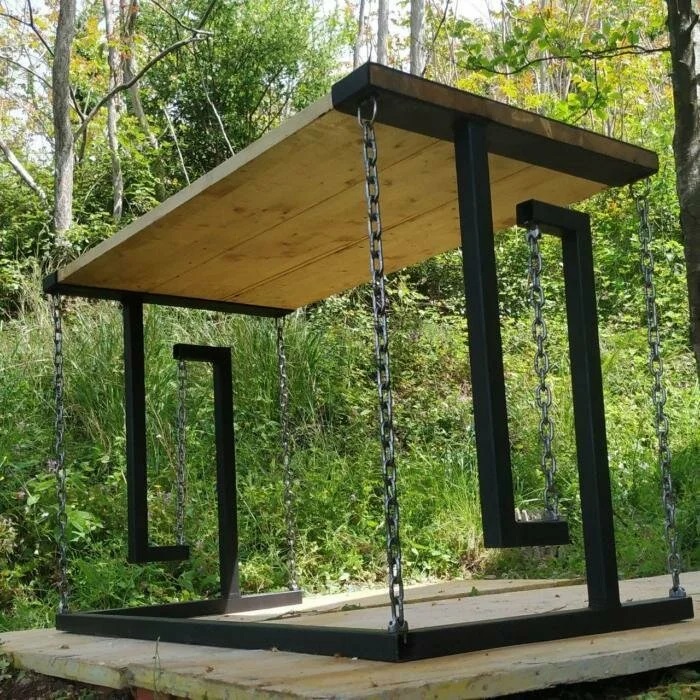
Tensegrity table. Source
Tensegrity, tensional integrity or floating compression is a structural principle based on a system of isolated components under compression inside a network of continuous tension, and arranged in such a way that the compressed members (usually bars or struts) do not touch each other while the prestressed tensioned members (usually cables or tendons) delineate the system spatially (Wiki).
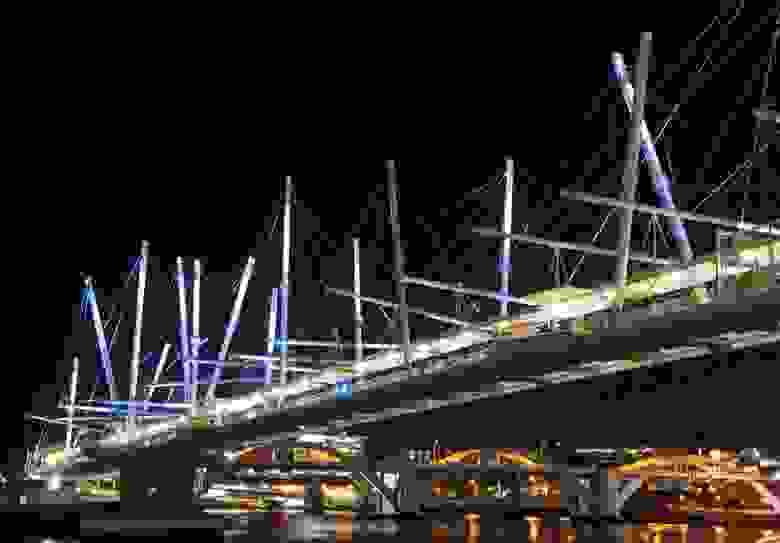
The world's largest Tensegrity bridge, Australia. Source
One of the oldest areas of robotics, industrial manipulators, is now experiencing a new stage in its development, associated with the so-called collaborative robotics. In the speech of specialists in this field, two terms can be heard with great frequency — stiffness and compliance. In industrial robotics, compliance refers to flexibility. A non-compliant stiff robot is a device that works independently of the external force affecting the robot: the robot's end-effector will follow exactly the same trajectory every time. On the other hand, the end-effector of a compliant robot can move along different trajectories to complete a task and apply different forces to the object. For example, a robot can grip an egg without breaking it. Controlled stiffness is at the core of collaborative robotics.
The ideas for using Tensegrity in robotics come from collaborative and «soft» robotics. Tensegrity structures are lightweight, impact-resistant and make it possible to control their stiffness (compliance) and configuration (shape).
The most famous example of the use of tensegrity in robotics is the NASA Super Ball Bot, a foldable ground robot based on tensegrity that NASA planned to use to explore planetary surfaces. It can withstand significant impact, has a sphere-like structure of cables and bars that can withstand a drop from a spacecraft high above a planetary surface. Once on the planet, the robot can roll in any direction by controlling the lengths of the bars.
IEEE Spectrum video about NASA SUPERball v2
Innopolis University is developing a mathematical apparatus for modeling, designing and controlling robotic systems with stress-coupled structures with variable stiffness (this is Tensegrity) — a fundamental work that can be used in a variety of robots, for example, tensegrity manipulators, walking robots and others.
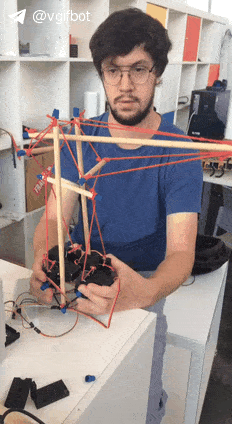
Tensegrity manipulator and Oleg Balakhnov, researcher of Innopolis University
Oleg was the first to start prototyping tensegrity robots in Innopolis University, starting from wooden sticks and rubber bands. A photo of a construction made of sushi sticks, perhaps, can also be found somewhere in the chats.
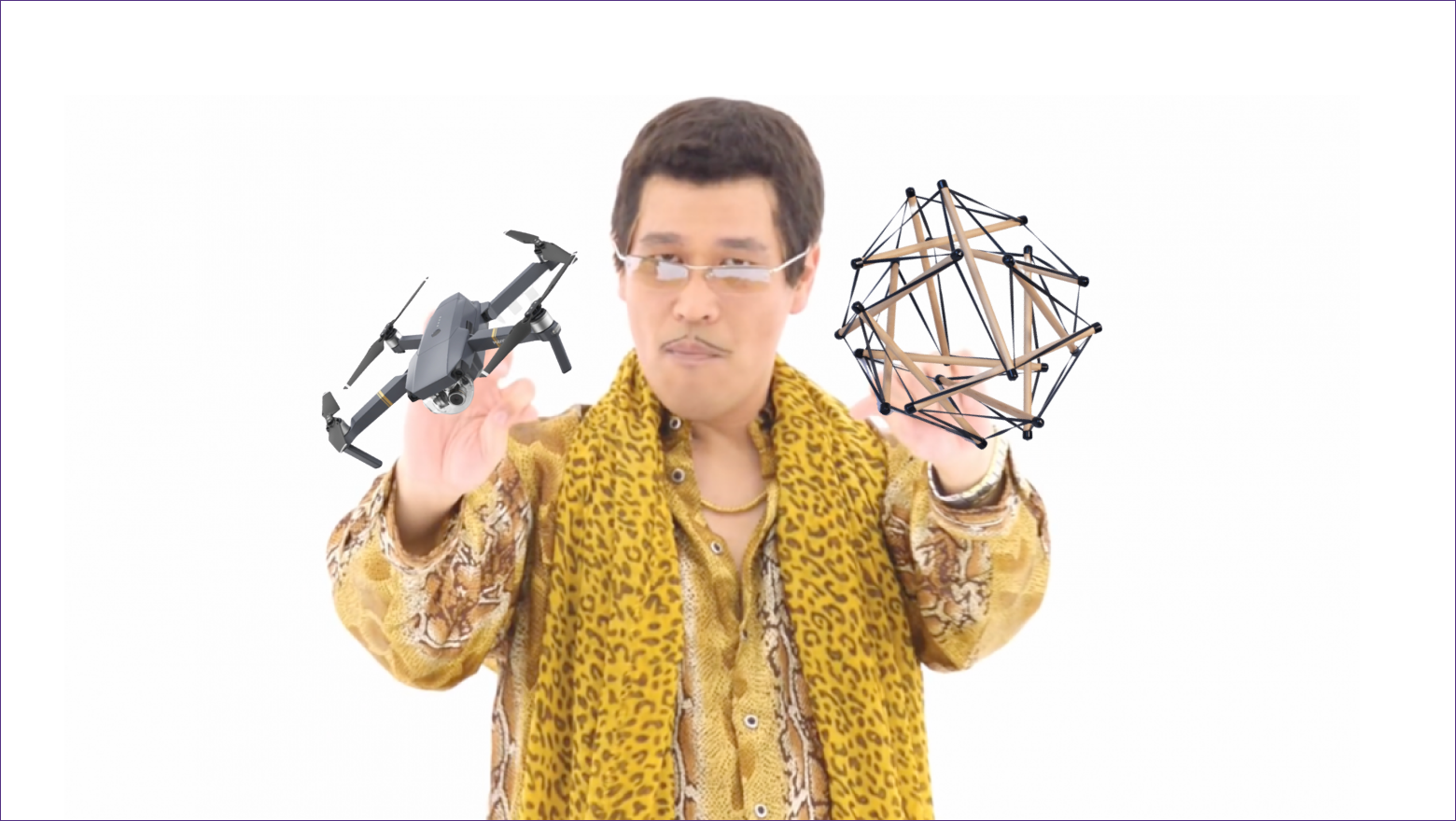
You probably got it.
Once in our garage I passed by a strange design that attracted the eyes.
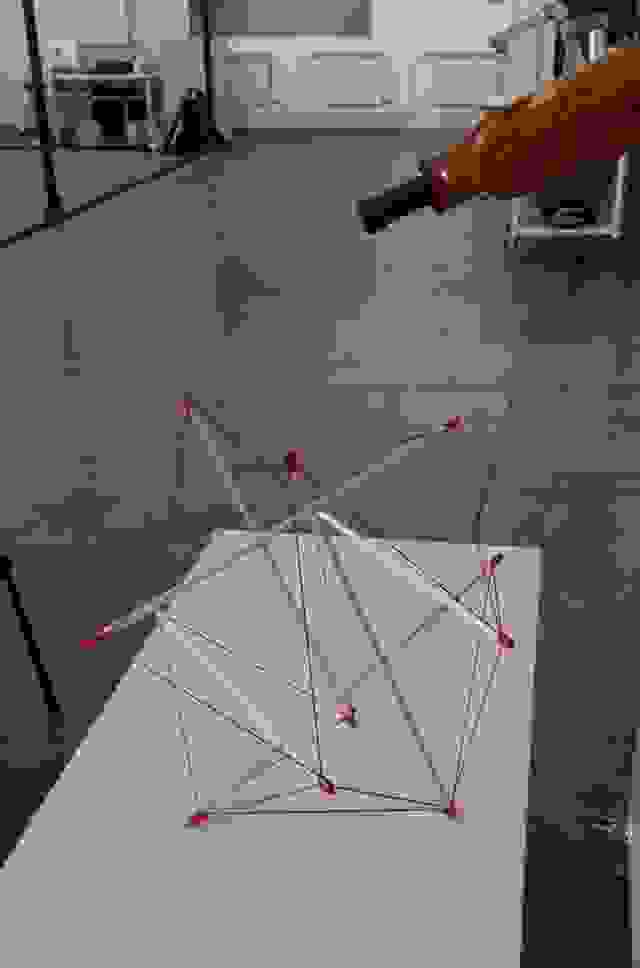
I asked: «What is it?» I was told «an unkillable structure — drop it, but it does not break.»
I broke (actually just shrunk — changed shape because the rubber bands were loose and dislocated). But we need such a design for drones! And an adventurous experiment was started.
Video with Tensegrity Survival Test

Sergey approves of an adventurous experiment. Jeff Bezos also
Sergey Savin is a senior researcher, associate professor, a serious scientist with a defended candidate's thesis at the age of 25, and many rating publications. He is one of the founding fathers of Tensegrity Robotics at Innopolis University, and has received several grants to develop Tensegrity Robots.

Igor is considering an idea
Dmitry, Oleg and Hanny are assembling the first tencodron. Dmitry Devitt GigaFlopsis is a researcher and graduate student at Innopolis University, the one who applied the most modern technologies — carbon tubes and kevlar threads, 3D printing with carbon and soft plastic, implemented everything and made it fly.

The process of assembling the Tensodrone
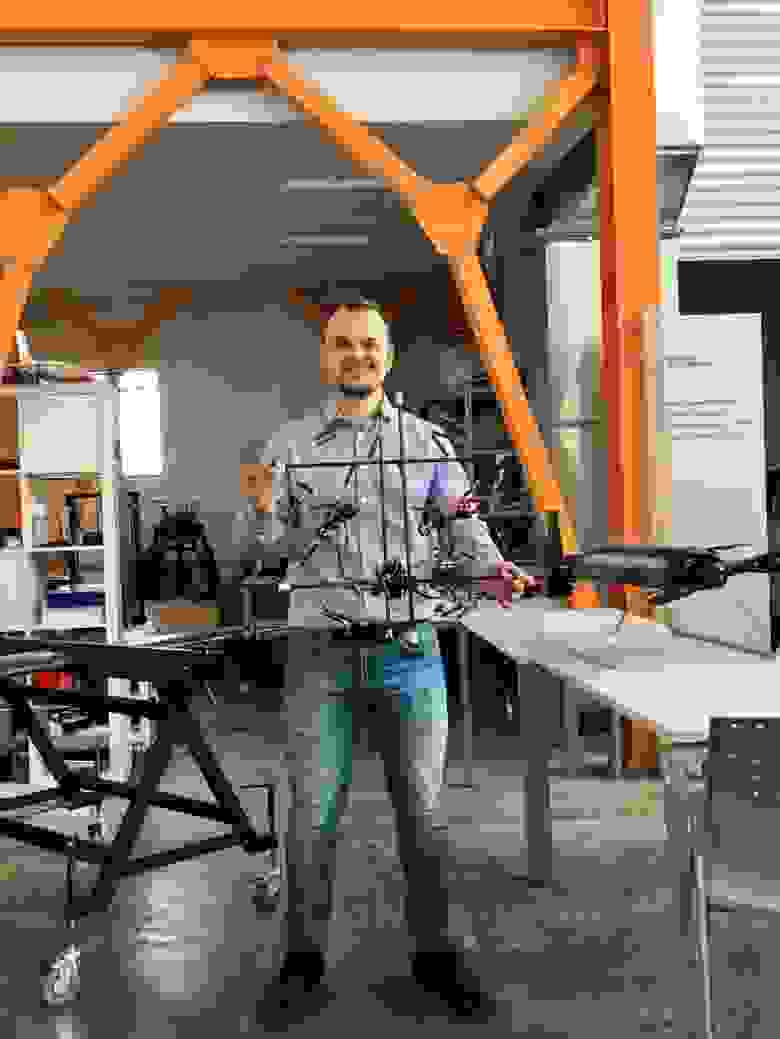
Hurray, happened!
Dmitry is also the first (after the Tensodrone) actor in the epic videos. Please, check it out:
A game of two actors starring themselves. Video by DeluuusiOn
The design of the first drone prototype turned out as follows:
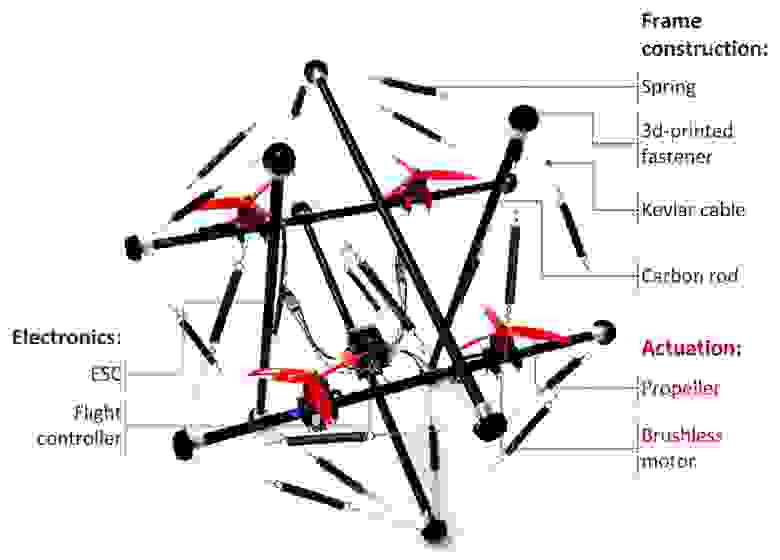
Innopolis University Tensodrone prototype design
The basic 6-rod tensegrity design was used. Unlike rigid quadcopters, we have two pairs of motors with propellers mounted on different bars. Also, none of them is rigidly connected to the autopilot, which is located on the lower bar.
The onboard electronics and electromechanical components of the prototype drone include:
Bars are made from carbon fiber tubes. End caps and other small parts are 3D printed.
The main problem of controlling this drone in comparison with a conventional rigid drone is vibrations, which, firstly, are greater, and secondly, they are different for the controller and motors installed on different bars (although this can also be a plus as vibration isolation).
Early Tensodrone Tests: Vibrations (sorry for vertical video)
Early in-flight Tensodrone Tests: Vibration
We solve these problems in two ways — by improving the design to reduce vibrations during flight and the development of control and state estimation algorithms in order to suppress vibrations and better control, including taking into account additional data from IMU sensors on the bars and a dynamic model of the tensegrity structure.
Falling to the floor followed by takeoff, indoors (unedited video)
There are still many interesting things to happen in the future:patent application, writing a scientific article with detailed research, testing new design options (oh, we have a lot of them).
Now Tensodrone could fly itself, according to a given mission (using GPS outdoor and visual odometry indoor). It is obvious to us that it could be used for indoor inspections. Except for low-level control and shape, the Tensodrone is a regular drone, so we can integrate our motion planning algorithms into it for autonomous exploration and obstacle avoidance.
An example of performing an automatic exploration. Master's project by Victor Massagué, our alumnus, PhD student and in the near future, hopefully, an employee
The potential of a Tensegrity drone design is much greater than a simple drone.
Do you remember the Foldable Drone from the video above? What about SUPERball?
So, if you actively change the lengths of the bars or the tension of the cables of the tensegrity drone, you can control its configuration (or, more simply, the shape)!
The result is Foldable Morphing Tensodrone. We are actively working in this research area.

Foldable Morphing Tensodrone (varying shape in flight) by Innopolis University (concept)
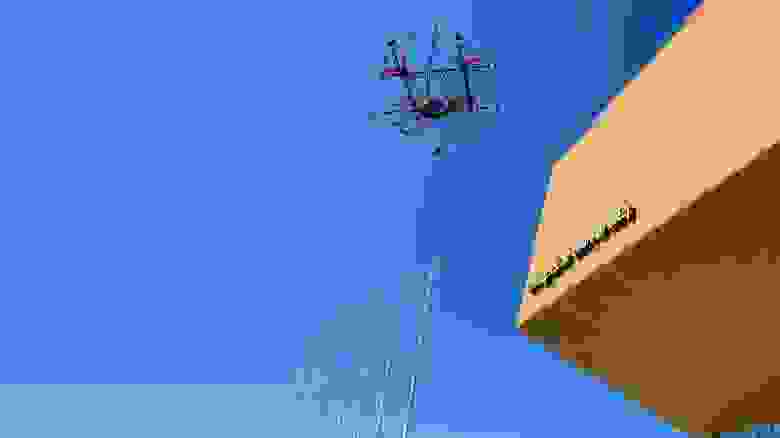
The use of tensegrity for a UAV design is novel, opens up new research challenges, and at the same time the existing prototype already shows that the idea works and can be applied.
Very controversial, very unusual, very strange, but it works! At the intersection of architecture, collaborative robotics and unmanned aerial vehicles.
Introducing: Tensodrone™.

Tensodrone is a multi-rotor UAV of a new design with collision protection, made on the principle of tensegrity. This approach allows for the combination of the protective cage and the airframe in one structure, increasing impact resistance with less weight. The project is a vivid example of the interaction of various teams of the Center for Competences of the National Technology Initiative in the field of «Robotics and Mechatronics» established at the Innopolis University in 2018.
Drones fall
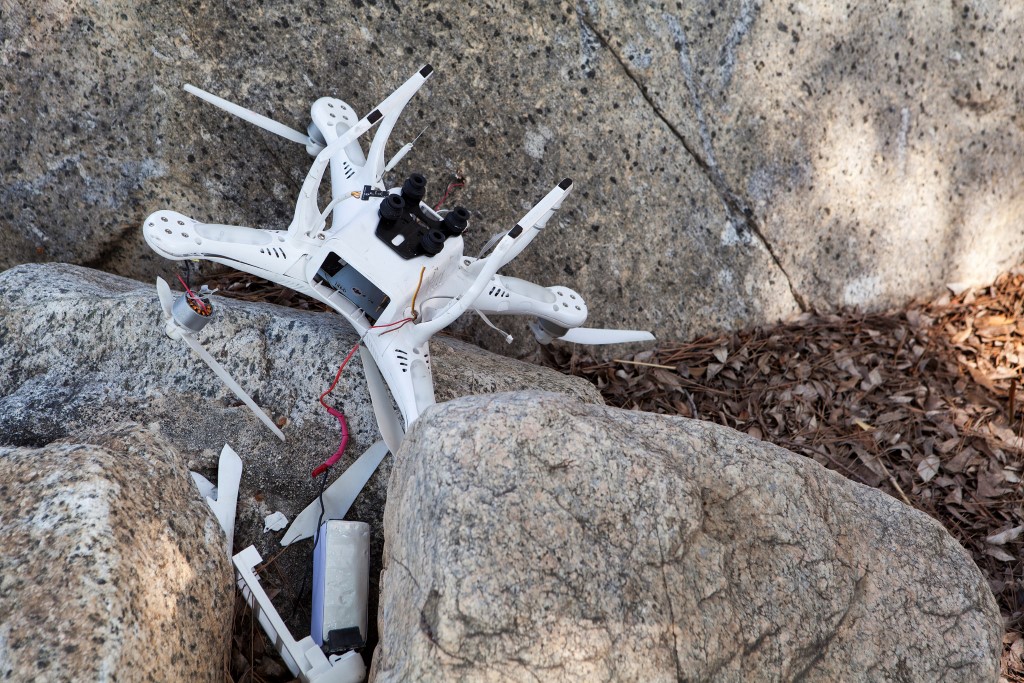
Source
Just because they fly.
Drone developers are trying to make control systems, motors, sensors, autopilots, on-board computers and software as reliable as possible, but the risk remains. If you are a drone developer dealing with a drone prototype, moreover, you should prepare for falls and crashes (make a few extra pieces or a few dozens?). In addition to internal factors, there are obviously external factors — wind, passive obstacles, active influence.
Hardly anyone will argue, drones fall, collide, crash. You can try to avoid this, you can prepare for it. What's better? It's up to the developer, user and authorities.
I prefer to use both methods. But in this article we will focus on how to avoid the consequences of a fall or collision of a UAV, assuming that such a collision is possible.
Protective Structures
The most straightforward approach to avoiding the consequences of a UAV crash or collision is a protective cage and other protective structures.
There are 2 tasks here — to protect the drone from damage and to protect the environment where the drone operates and the people in it from the drone.
The basic version of the design, rather related to protect people from the drone, is the propeller guard.

AR.Drone 2.0 drone with propeller guards. Source
There are also interesting solutions, inspired by origami, for foldable flexible propeller guards (and even frame designs), which are being developed at EPFL by Prof. Floreano’s group.
The prevailing design for protecting the drone itself (and at the same time people from it) is a protective cage. The quadcopter itself is inside the cage.
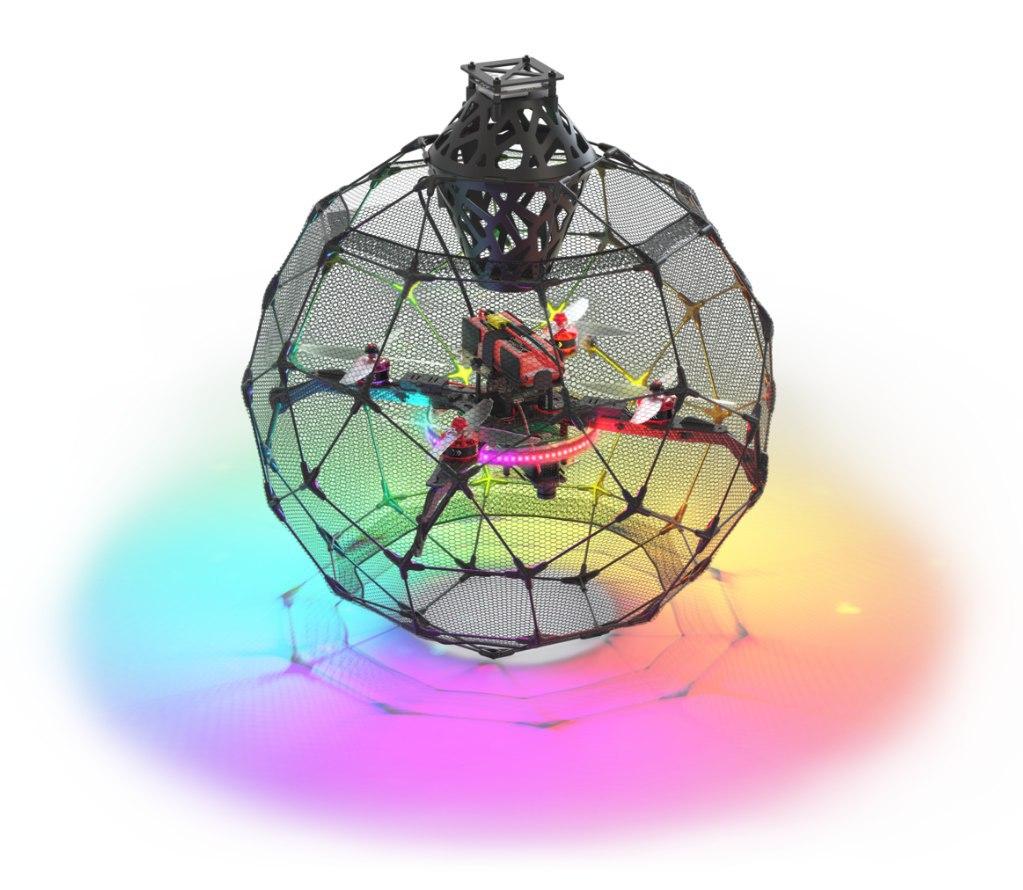
The Clover drone from COEX
Russian company COEX makes drones for educational purposes, which by default have propeller guards and, optionally, a protective cage.
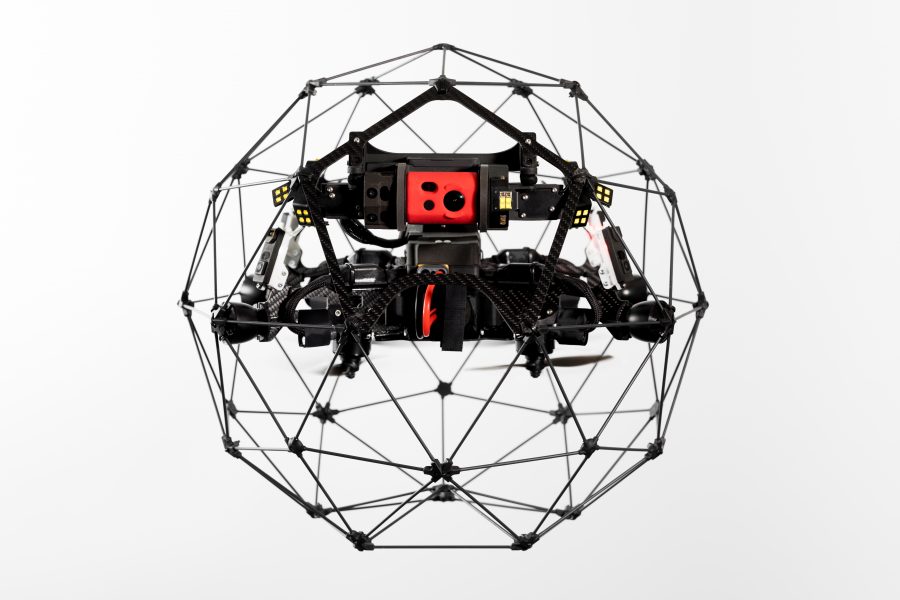
Flyability ELIOS drone
Flyability, a Swiss company, produces perhaps the most commercially successful drone ELIOS with a protective cage for indoor inspections. The originality of the design consists of attaching the protective cage to the frame of the copter on a movable suspension (gimbal) with the possibility of stabilization. I also recently learned about a certain similar Russian startup: Safecopter.

Dronistics Drone
Startup Dronistics from EPFL (emerged from Floreano’s group) offers a drone with a foldable cage for safe delivery.
Still, they break
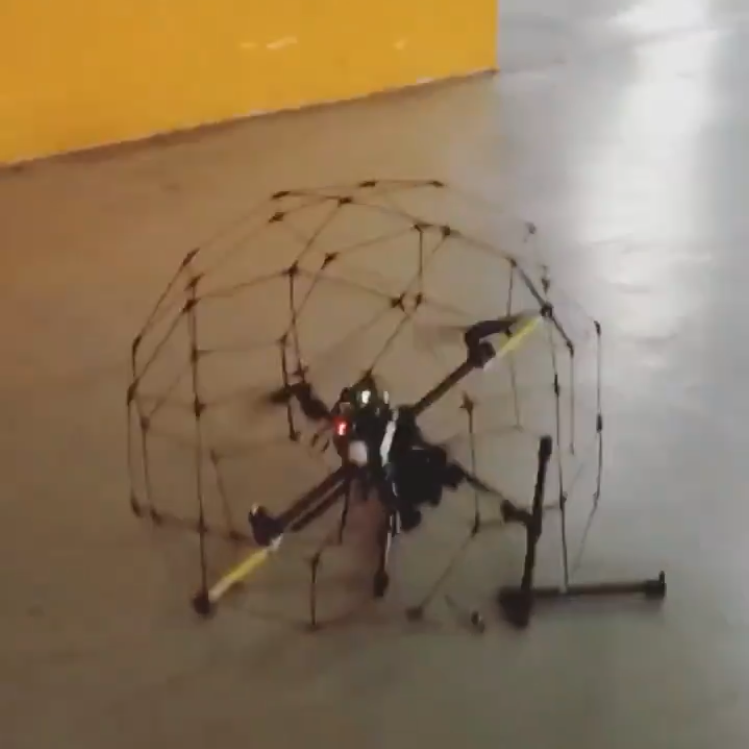

The disadvantage of drone cages is the increase in the mass of the structure by the amount of the mass of the protective cage and the elements of its attachment to the UAV. The desire to reduce the weight of the structure leads to a decrease in the strength of the protection.
Drones with variable geometry
Another direction related to the ideas of a protected drone (and not only to it) is folding drones and drones with variable geometry (morphing) drones. This refers to a drone capable of changing its geometry in flight. Foldable structures are made in order to avoid damage to the drone (for example, the drone can «cringe» before impact), and also — the drone can, for example, be folded to a compact size for flying through narrow windows.
You may have seen a cool morphing drone video from Switzerland (ETH + EPFL + UZH):
Morphing drone
This idea is also interesting and close to us, later I'll tell you why.
Tensegrity

Tensegrity table. Source
Tensegrity, tensional integrity or floating compression is a structural principle based on a system of isolated components under compression inside a network of continuous tension, and arranged in such a way that the compressed members (usually bars or struts) do not touch each other while the prestressed tensioned members (usually cables or tendons) delineate the system spatially (Wiki).

The world's largest Tensegrity bridge, Australia. Source
Alternative application :)

Alternative application as clothes dryer :)
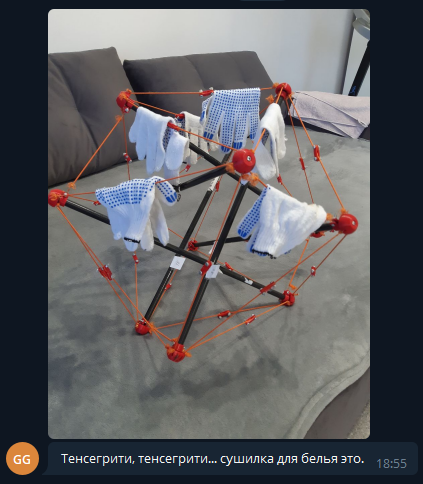
Alternative application as clothes dryer :)
Tensegrity in robotics
One of the oldest areas of robotics, industrial manipulators, is now experiencing a new stage in its development, associated with the so-called collaborative robotics. In the speech of specialists in this field, two terms can be heard with great frequency — stiffness and compliance. In industrial robotics, compliance refers to flexibility. A non-compliant stiff robot is a device that works independently of the external force affecting the robot: the robot's end-effector will follow exactly the same trajectory every time. On the other hand, the end-effector of a compliant robot can move along different trajectories to complete a task and apply different forces to the object. For example, a robot can grip an egg without breaking it. Controlled stiffness is at the core of collaborative robotics.
The ideas for using Tensegrity in robotics come from collaborative and «soft» robotics. Tensegrity structures are lightweight, impact-resistant and make it possible to control their stiffness (compliance) and configuration (shape).
The most famous example of the use of tensegrity in robotics is the NASA Super Ball Bot, a foldable ground robot based on tensegrity that NASA planned to use to explore planetary surfaces. It can withstand significant impact, has a sphere-like structure of cables and bars that can withstand a drop from a spacecraft high above a planetary surface. Once on the planet, the robot can roll in any direction by controlling the lengths of the bars.
IEEE Spectrum video about NASA SUPERball v2
Tensegrity robots at Innopolis University
Innopolis University is developing a mathematical apparatus for modeling, designing and controlling robotic systems with stress-coupled structures with variable stiffness (this is Tensegrity) — a fundamental work that can be used in a variety of robots, for example, tensegrity manipulators, walking robots and others.

Tensegrity manipulator and Oleg Balakhnov, researcher of Innopolis University
Oleg was the first to start prototyping tensegrity robots in Innopolis University, starting from wooden sticks and rubber bands. A photo of a construction made of sushi sticks, perhaps, can also be found somewhere in the chats.
Tensegrity Vibrobot
Synergetic Effect

You probably got it.
I have a drone, I have tensegrity. Ugh! (Tensodrone)
Once in our garage I passed by a strange design that attracted the eyes.

I asked: «What is it?» I was told «an unkillable structure — drop it, but it does not break.»
I broke (actually just shrunk — changed shape because the rubber bands were loose and dislocated). But we need such a design for drones! And an adventurous experiment was started.
Video with Tensegrity Survival Test
More arduous test
Squishy robotics is a startup that makes tensegrity robots for rescue operations in case of disasters, remote monitoring and space research, and drops them from the copter.
Squishy robotics is a startup that makes tensegrity robots for rescue operations in case of disasters, remote monitoring and space research, and drops them from the copter.
Gamble
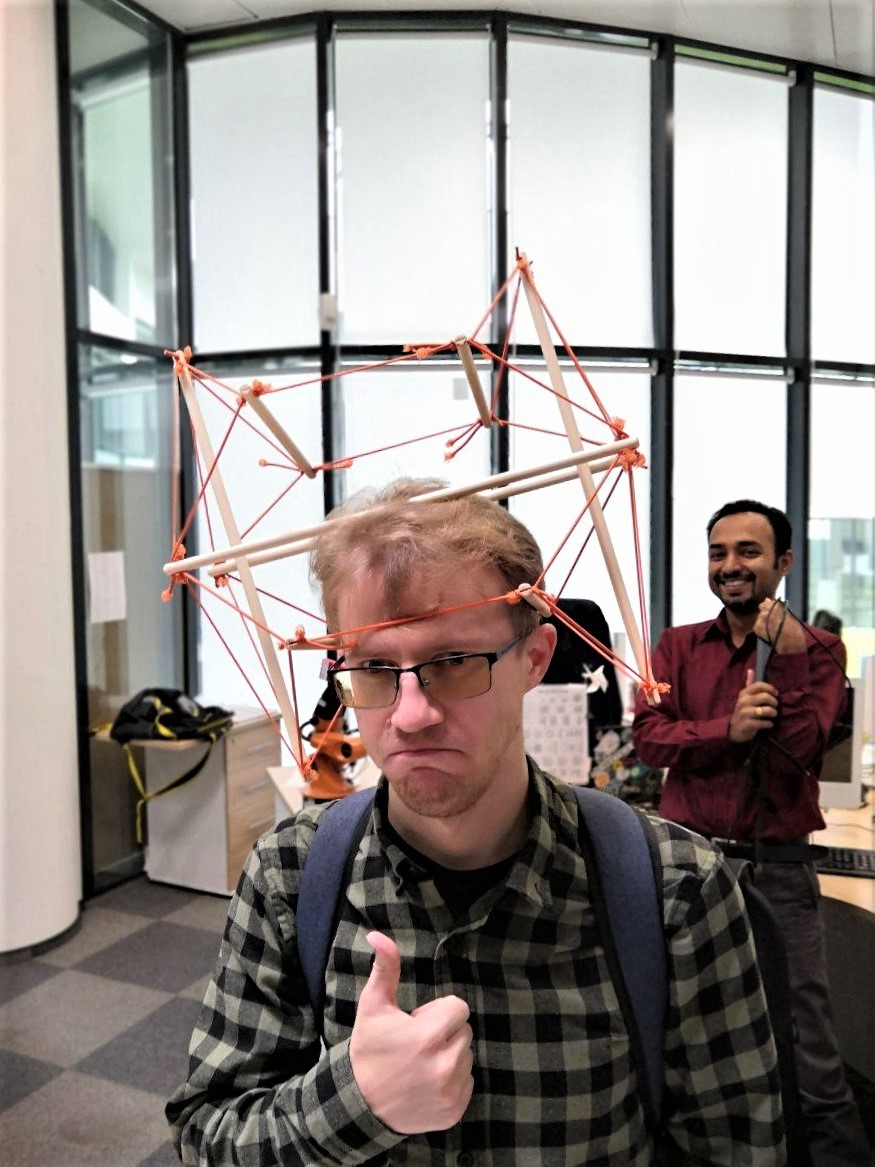
Sergey approves of an adventurous experiment. Jeff Bezos also
Sergey Savin is a senior researcher, associate professor, a serious scientist with a defended candidate's thesis at the age of 25, and many rating publications. He is one of the founding fathers of Tensegrity Robotics at Innopolis University, and has received several grants to develop Tensegrity Robots.
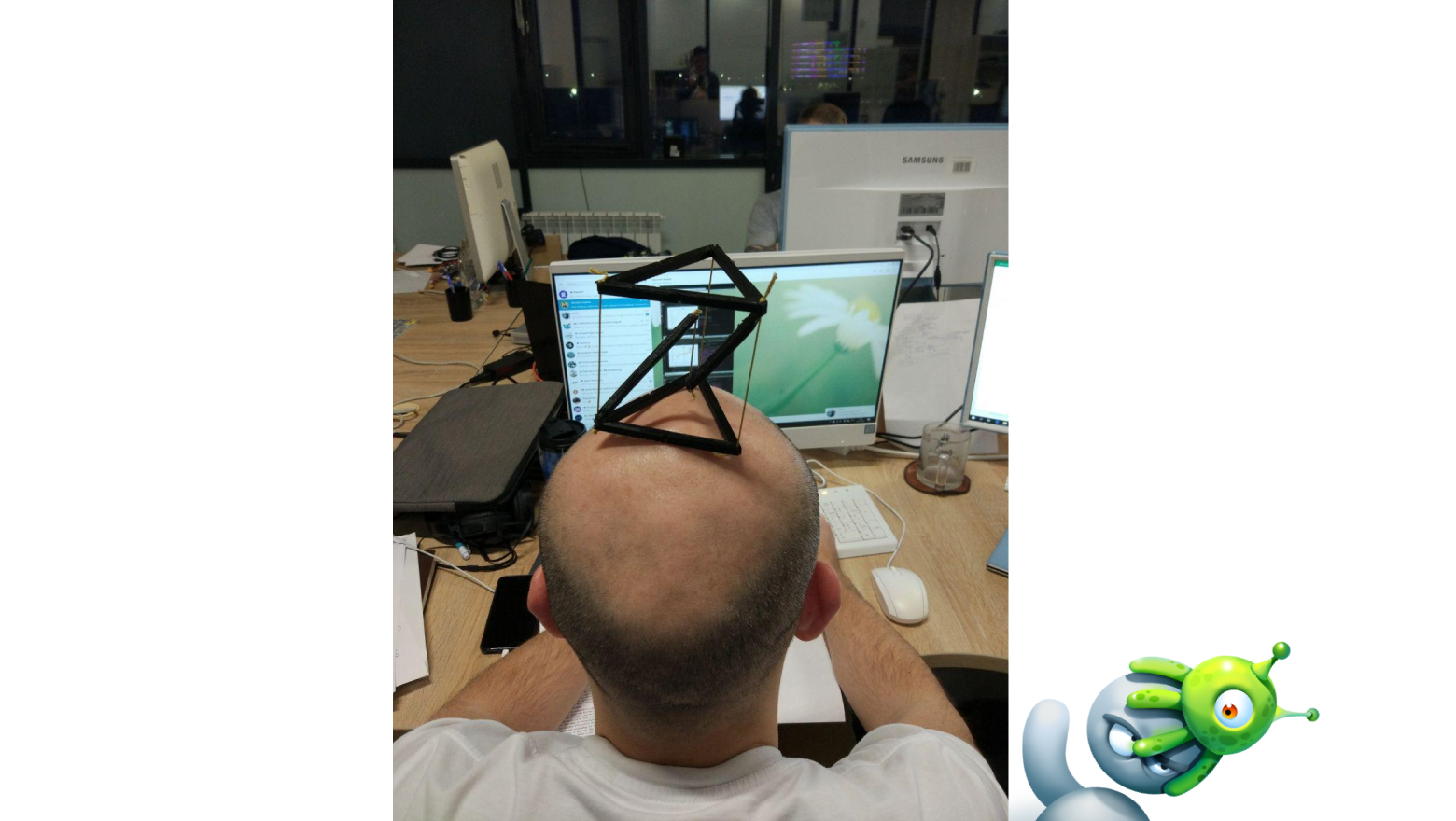
Igor is considering an idea
Dmitry, Oleg and Hanny are assembling the first tencodron. Dmitry Devitt GigaFlopsis is a researcher and graduate student at Innopolis University, the one who applied the most modern technologies — carbon tubes and kevlar threads, 3D printing with carbon and soft plastic, implemented everything and made it fly.
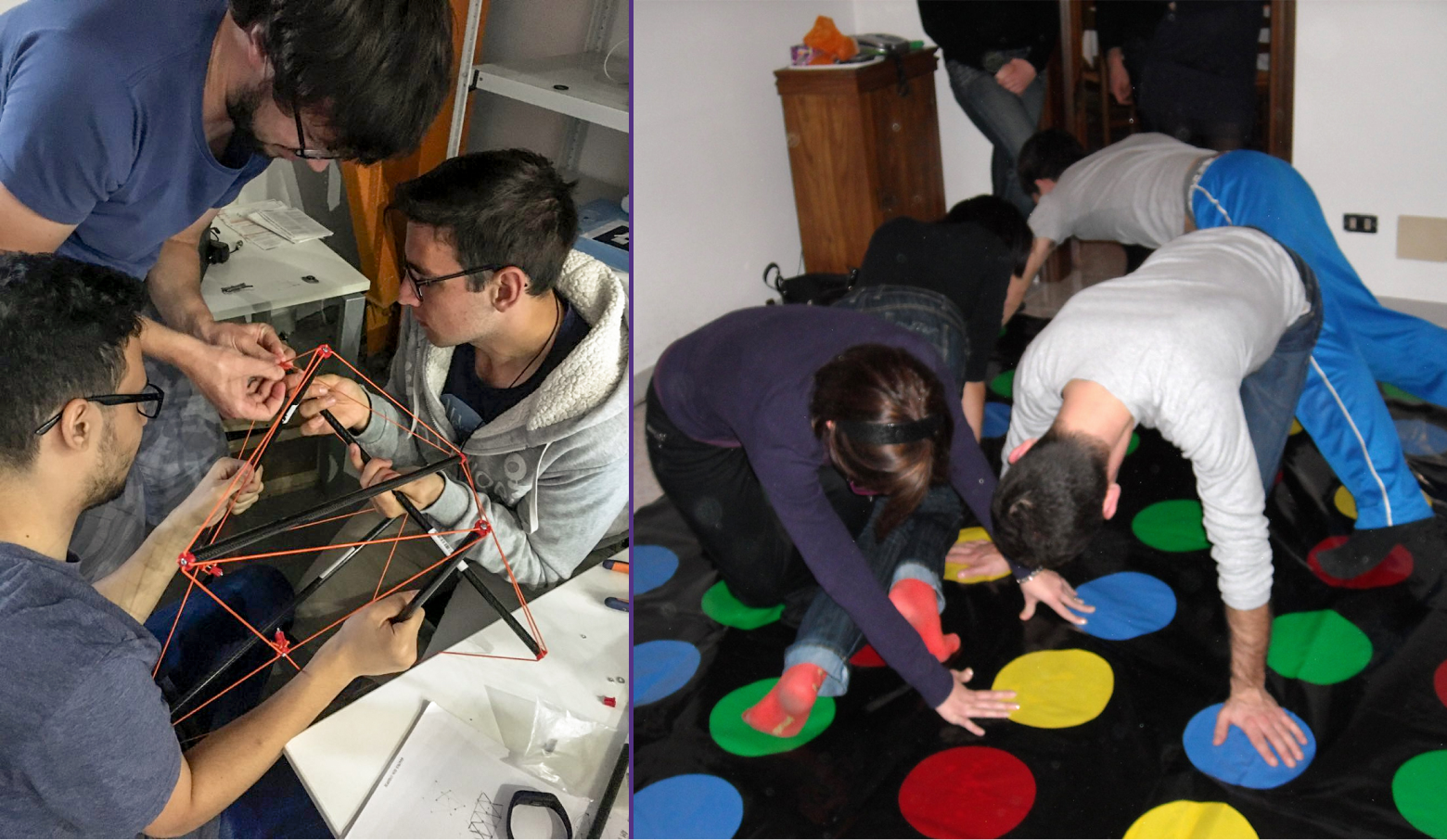
The process of assembling the Tensodrone

Hurray, happened!
It Flies!
Dmitry is also the first (after the Tensodrone) actor in the epic videos. Please, check it out:
A game of two actors starring themselves. Video by DeluuusiOn
More about the prototype design
The design of the first drone prototype turned out as follows:

Innopolis University Tensodrone prototype design
The basic 6-rod tensegrity design was used. Unlike rigid quadcopters, we have two pairs of motors with propellers mounted on different bars. Also, none of them is rigidly connected to the autopilot, which is located on the lower bar.
The onboard electronics and electromechanical components of the prototype drone include:
- a CUAV Pixhawk v5 mini autopilot,
- a 3s 1400 mAh battery,
- a Racerstar REV35 35A BLheliS 3-6S ESC regulator and
- Racerstar Racing Edition BR2205 2300KV motors,
- MPU9250 IMU sensors.
Bars are made from carbon fiber tubes. End caps and other small parts are 3D printed.
Control problems
The main problem of controlling this drone in comparison with a conventional rigid drone is vibrations, which, firstly, are greater, and secondly, they are different for the controller and motors installed on different bars (although this can also be a plus as vibration isolation).
Early Tensodrone Tests: Vibrations (sorry for vertical video)
Early in-flight Tensodrone Tests: Vibration
We're not alone
It turns out we had a competitor.
Back at the beginning (almost a year ago), when we were making a prototype, we found this video from the guys from Imperial College London:
The authors came up with the same idea as us: tensegrity for drones is interesting.
Because no design details and, moreover, no prototype were presented, we continued our work.
Later, when we had a flying sample, we received a report from the same group:
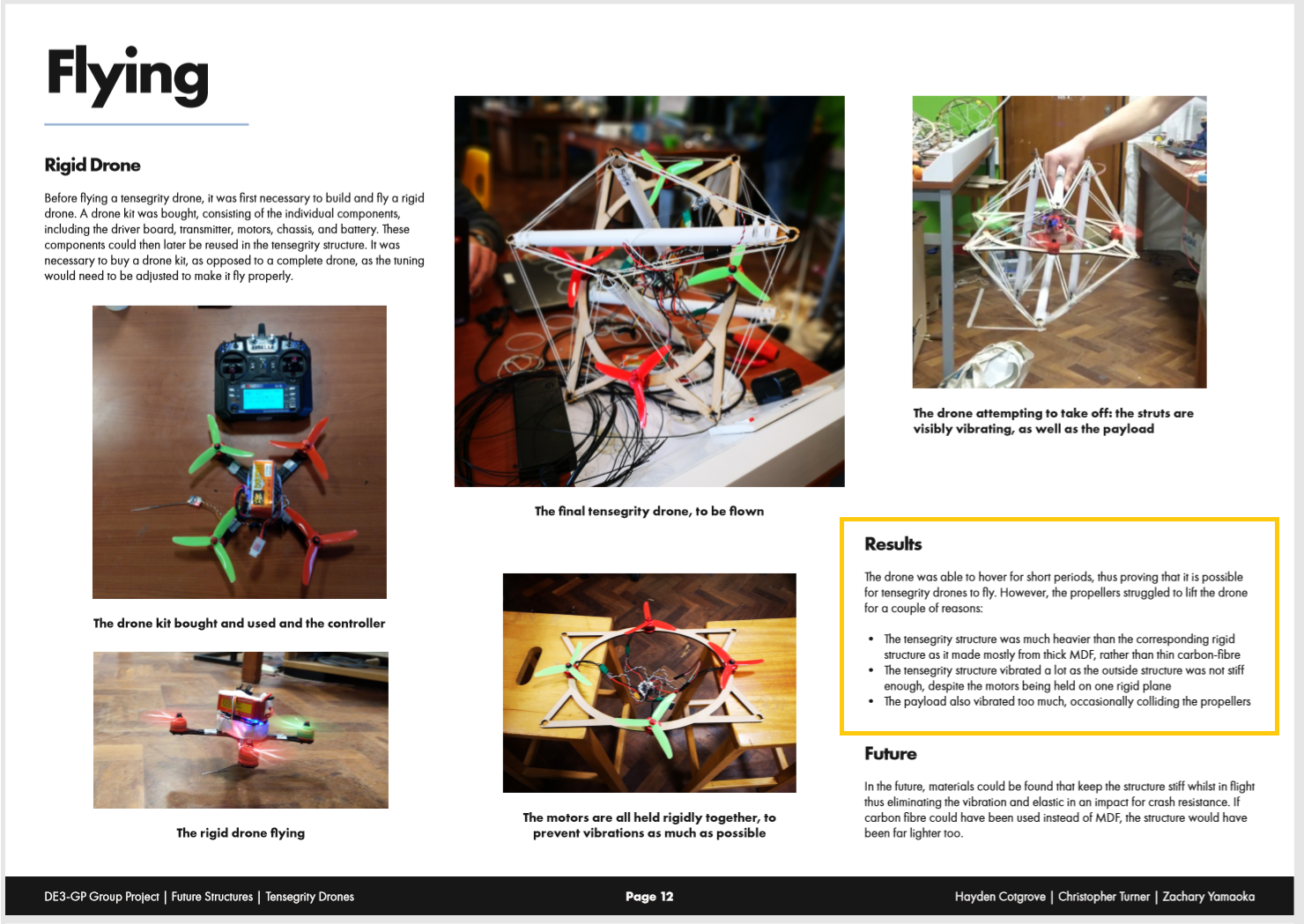
Report by Hayden Cotgrove, Christopher Turner, Zachary Yamaoka Tensegrity Drones. The link no longer works
First of all, their prototype didn't fly. Secondly, their design is a rigid drone inside a tensegrity cage, but we have elements of the drone built (and spread) into the tensegrity structure, which is both a frame and a cage at the same time. Thus, imho, here we have both conceptual problems and problems of qualitative implementation.
Back to control and vibration issues. This is what Hayden Cotgrove, Christopher Turner, Zachary Yamaoka wrote in a report:
Back at the beginning (almost a year ago), when we were making a prototype, we found this video from the guys from Imperial College London:
The authors came up with the same idea as us: tensegrity for drones is interesting.
Because no design details and, moreover, no prototype were presented, we continued our work.
Later, when we had a flying sample, we received a report from the same group:

Report by Hayden Cotgrove, Christopher Turner, Zachary Yamaoka Tensegrity Drones. The link no longer works
First of all, their prototype didn't fly. Secondly, their design is a rigid drone inside a tensegrity cage, but we have elements of the drone built (and spread) into the tensegrity structure, which is both a frame and a cage at the same time. Thus, imho, here we have both conceptual problems and problems of qualitative implementation.
Back to control and vibration issues. This is what Hayden Cotgrove, Christopher Turner, Zachary Yamaoka wrote in a report:
- The tensegrity structure was much heavier than the corresponding rigid structure as it made mostly from thick MDF, rather than thin carbon-fibre
- The tensegrity structure vibrated a lot as the outside structure was not stiff enough, despite the motors being held on one rigid plane
- The payload also vibrated too much, occasionally colliding the propellers
We solve these problems in two ways — by improving the design to reduce vibrations during flight and the development of control and state estimation algorithms in order to suppress vibrations and better control, including taking into account additional data from IMU sensors on the bars and a dynamic model of the tensegrity structure.
Falling to the floor followed by takeoff, indoors (unedited video)
A few more test videos
Here are some more videos of our tests for those interested, when the vibrations are already at an acceptable level. In the spoiler, because there are a lot of them.
Fall on the stairs (and feels good)
Autonomous mission flight test outdoor
Indoor Demo with a hitting the wall
Fall on the stairs (and feels good)
Autonomous mission flight test outdoor
Indoor Demo with a hitting the wall
What's Next?
(Spring, Summer) Research
There are still many interesting things to happen in the future:
(Fall, Winter) Application
Now Tensodrone could fly itself, according to a given mission (using GPS outdoor and visual odometry indoor). It is obvious to us that it could be used for indoor inspections. Except for low-level control and shape, the Tensodrone is a regular drone, so we can integrate our motion planning algorithms into it for autonomous exploration and obstacle avoidance.
An example of performing an automatic exploration. Master's project by Victor Massagué, our alumnus, PhD student and in the near future, hopefully, an employee
… and (Spring) Research
The potential of a Tensegrity drone design is much greater than a simple drone.
Do you remember the Foldable Drone from the video above? What about SUPERball?
So, if you actively change the lengths of the bars or the tension of the cables of the tensegrity drone, you can control its configuration (or, more simply, the shape)!
The result is Foldable Morphing Tensodrone. We are actively working in this research area.

Foldable Morphing Tensodrone (varying shape in flight) by Innopolis University (concept)
Conclusions

The use of tensegrity for a UAV design is novel, opens up new research challenges, and at the same time the existing prototype already shows that the idea works and can be applied.